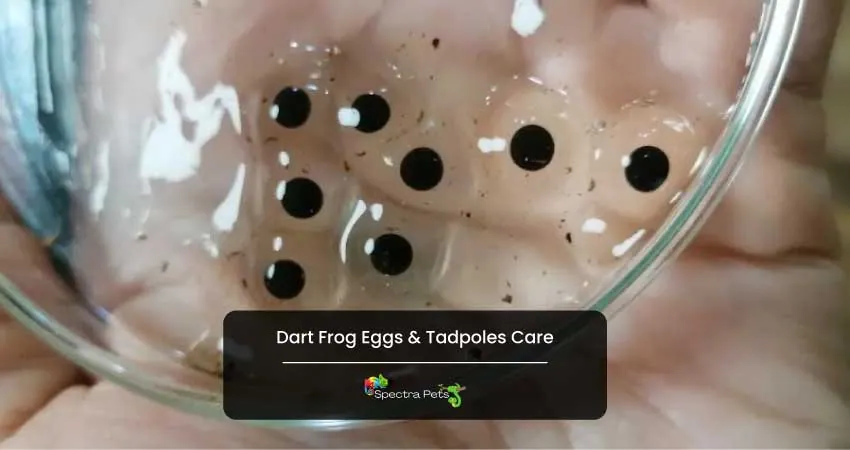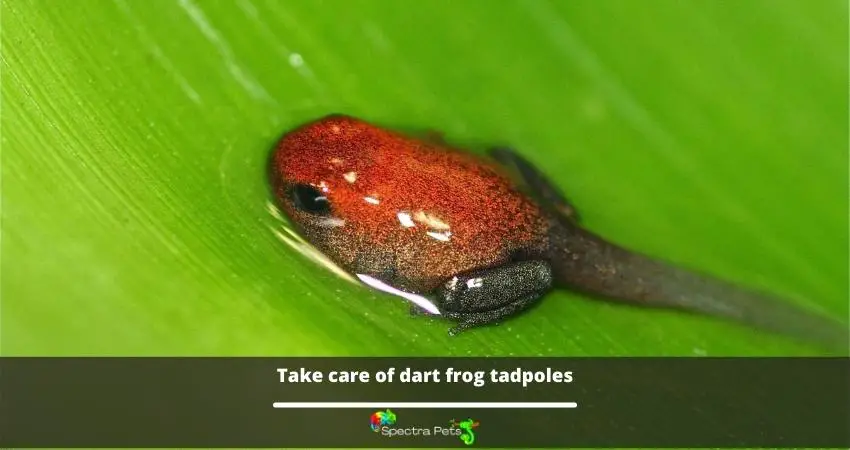Undoubtedly bringing more colorful frogs into your room is more fun as a frog hobbyist. In captivity, providing the right care to the egg & tadpoles will eventually help you to see the offspring of your current dart frog collection.
Taking care of dart frog eggs and tadpoles is a lot of work – but it’s definitely worth it when you see those little guys starting to hop around.
Avoiding any mistakes in the whole process of taking care of will surely increase your dart frog family members by around 14 weeks. If you’re considering taking on this responsibility yourself, here are some tips to help you get started. Happy froggin’!
Relevant Articles:
Dart frog eggs & tadpoles care
Dart frogs eggs and tadpoles can be a bit tricky to take care of, but with the proper monitor, you will be able to do it like a pro! Follow all the guidelines closely so that your little froggies have the best chance at making it to adulthood.

Taking care of the eggs
Here in the following you will see the step-by-step process of taking care of the dart frog egg…
Step 1: Collect the eggs
The first step in raising tadpoles is getting viable eggs. Different dart frog species can lay their eggs inside the tank in a unique spot.
However, mostly the eggs will be on the leaves or on a petri dish beneath the coco huts. Don’t be surprised if you find eggs on the terrarium walls.
Moreover, different dart frogs lay eggs in clutches with different numbers of eggs. Here you can see some examples of dart frog clutch…
| Name | Scientific Name | Clutch ( Number of eggs) |
| Strawberry poison dart frog | Oophaga pumilio | 4-6 eggs |
| Golden poison dart frog | Phyllobates bicolor | 10-20 eggs |
| Blue poison dart frog | Dendrobates tinctorius | 5-6 eggs |
| Green and black poison dart frog | Dendrobates auratus | 4-10 eggs |
| Bumble bee dart frog | Dendrobates leucomelas | 2-12 eggs |
Now you need to collect the good eggs from their laying spots to the petri dish using a spoon. You have to keep the eggs moist all the time. A small pool of reverse osmosis water touching the eggs would be okay for the process.
Step 2: Provide the right temperature
For optimum growth, you should keep the dart frog eggs at mid-70 Fahrenheit. It’s time to monitor the egg development process.
Step 3: Remove the bad eggs
You will see the good eggs will be dark gray or black in color and round in shape. While the bad eggs will become white or light gray and may even burst. When eggs start to look like this it means that they are infertile and should be discarded.
Step 4: Wait for the egg to become a tadpole
As soon as you see a small embryo develop on the top of the yolk, you know you have fertile eggs. Usually, eggs develop after four to five days, and tadpoles with gills begin to form after 14 to 16 days.
The long red thread-like external gills help the tadpoles breathe well inside the egg once the external gills are absorbed by the tadpole it will be ready to hatch in several days.
Once hatched from the egg, the tadpoles will appear lifeless for several days as they absorb the rest of the nutrients from their yolks.
Taking care of your tadpole

So you’ve found a frog or toad spawn and watched the eggs develop into tadpoles. Now what? Caring for tadpoles isn’t difficult, but there are a few things you need to do to make sure they have the best chance of surviving adulthood.
Step 1:Provide a safe place for each tadpole
First, you need to provide them with a suitable home individually. Because the dart frog tadpoles have cannibalistic attributes. A small plastic storage container will do the trick. Make sure it has a tight-fitting lid, and punch a few holes in the top for ventilation. Fill the container with clean water.
Step 2: Add java moss & Indian almond leaf
Add some aquatic plants like java moss and Indian almond leaves for the tadpoles to hide in.
The benefit of the Indian almond is that it will release an ingredient called tannins into the water where you kept the tadpoles. This amazing leaf will provide not only shelter but also works as a powerful antifungal plus antibacterial agent.
Moreover, the java moss will add more oxygen to the tadpole’s container water. It will also increase the nitration consumption which works as an excellent filtering process. You must keep the tadpoles in shallow water so that they can easily swim up to the surface water and take in the air.
Step 3: Feeding the tadpole
Next, you need to feed your tadpoles. They will mostly eat algae and other aquatic plants, but you can also give them commercial tadpole food or boiled lettuce. Feed them small amounts several times a day. Beware though, you don’t want to feed the tadpole too much for the first 5-7 days.
For the healthy growth of the tadpoles, algae work great. You can feed the Zoo Med Aquatic Frog and Tadpole Food to them.
However, too much adding of algae can kill your tadpoles because they won’t be able to eat big amounts. As a result container water will become too polluted and they might die.
Also, you can provide the Sera micron that can provide an ample amount of protein and vitamins for the dart frog tadpoles. Weekly 2-3 times feeding would be perfect for the tadpoles.
Step 4: Maintain the temperature & change the water carefully
You must ensure the temperature always remains around 70-75 degrees Fahrenheit.
While changing the water per week make sure you change only 50% of the water at a time. You will notice that within the next few weeks the tadpole will grow quite faster.
During their growing process, the water evaporates, so you keep adding the fresh reverse osmosis water. Clean, rinse whatever utensil you use, however don’t use soap.
Step 5: Observe the development till 14 weeks
As the tadpoles grow, they will start to develop legs. After 6–8 weeks they will have visible back legs. At the end of 2 months, they will have front legs too.
At this point, you will need to provide them with a place to climb out of the water. A piece of driftwood or a shallow dish filled with gravel will work nicely.
Once the tadpoles have developed into frogs, you can release them into the wild or keep them as pets. If you choose to keep them, you will need to provide them with suitable habitats, including a water area and hiding places. frogs are great jumpers, so make sure their enclosure has a tight-fitting lid!
Final words
The dart frog’s life cycle is like any other amphibian with two different stages. And in both tadpoles and egg stages if they get an ample amount of food plus care then they will become beautiful froglets in the later stage.
Hopefully, you found the necessary info about how to take care of dart frog eggs and tadpoles.
